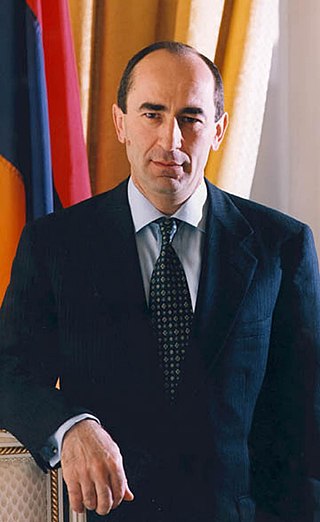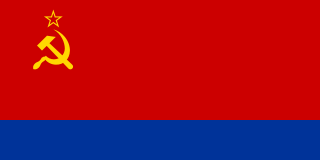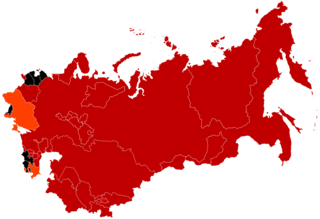
Robert Sedraki Kocharyan is an Armenian politician. He served as the President of the Nagorno-Karabakh Republic from 1994 to 1997 and Prime Minister of Nagorno-Karabakh from 1992 to 1994. He served as the second President of Armenia between 1998 and 2008 and as Prime Minister of Armenia from 1997 to 1998.

Heydar Alirza oghlu Aliyev was an Azerbaijani politician who was a Soviet party boss in the Azerbaijan Soviet Socialist Republic from 1969 to 1982, and the third president of Azerbaijan from October 1993 to October 2003.

The Azerbaijan Soviet Socialist Republic, also referred to as the Azerbaijani Soviet Socialist Republic, Azerbaijan SSR, Azerbaijani SSR, AzSSR, Soviet Azerbaijan or simply Azerbaijan, was one of the constituent republics of the Soviet Union between 1922 and 1991. Created on 28 April 1920 when the Russian Soviet Federative Socialist Republic brought pro-Soviet figures to power in the region, the first two years of the Azerbaijani SSR were as an independent country until incorporation into the Transcaucasian SFSR, along with the Armenian SSR and the Georgian SSR.

The Nakhichevan Autonomous Soviet Socialist Republic, abbreviated as Nakhichevan ASSR was an autonomous republic within the Azerbaijan SSR, itself a republic within the Soviet Union. It was formed on 16 March 1921 and became a part of the Azerbaijan SSR proper on 9 February 1924.

Levon Hakobi Ter-Petrosyan, also known by his initials LTP, is an Armenian politician and historian who served as the first president of Armenia from 1991 until his resignation in 1998.

The First Nagorno-Karabakh War was an ethnic and territorial conflict that took place from February 1988 to May 1994, in the enclave of Nagorno-Karabakh in southwestern Azerbaijan, between the majority ethnic Armenians of Nagorno-Karabakh backed by Armenia, and the Republic of Azerbaijan with support from Turkey. As the war progressed, Armenia and Azerbaijan, both former Soviet republics, entangled themselves in protracted, undeclared mountain warfare in the mountainous heights of Karabakh as Azerbaijan attempted to curb the secessionist movement in Nagorno-Karabakh.
Operation Ring, known in Azerbaijan as Operation Chaykand was the codename for the May 1991 military operation conducted by the Soviet Army, Internal Troops of the Ministry of Internal Affairs (MVD) of the USSR and OMON units of the Azerbaijan SSR in the Khanlar and Shahumyan districts of the Azerbaijani SSR, the Shusha, Martakert and Hadrut districts of the Nagorno-Karabakh Autonomous Oblast, and along the eastern border of the Armenian SSR in the districts of Goris, Noyemberyan, Ijevan and Shamshadin. Officially dubbed a "passport checking operation," the ostensible goal of the operation was to disarm "illegal armed formations" in and around Nagorno-Karabakh, referring to irregular Armenian military detachments that had been operating in the area. The operation involved the use of ground troops accompanied by a complement of military vehicles, artillery and helicopter gunships to be used to root out the self-described Armenian fedayeen.

United Armenia, also known as Greater Armenia or Great Armenia, is an Armenian ethno-nationalist irredentist concept referring to areas within the traditional Armenian homeland—the Armenian Highland—which are currently or have historically been mostly populated by Armenians. The idea of what Armenians see as unification of their historical lands was prevalent throughout the 20th century and has been advocated by individuals, various organizations and institutions, including the nationalist parties Armenian Revolutionary Federation and Heritage, the ASALA and others.

Vazgen Mikayeli Manukyan is an Armenian politician who served as the first Prime Minister of Armenia from 1990 to 1991. From 1992 to 1993, during the First Nagorno-Karabakh War, Manukyan was acting Defence Minister of Armenia. He was also a member of Armenia's parliament from 1990 to 2007.
The military history of the Republic of Artsakh contains information about the history of military actions or events performed by or in the Republic of Artsakh.

The New Union Treaty was a draft treaty that would have replaced the 1922 Treaty on the Creation of the Union of Soviet Socialist Republics (USSR) to salvage and reform the USSR. A ceremony of the Russian SFSR signing the treaty was scheduled for 20 August 1991 but was prevented by the August Coup a day earlier.
Presidential elections were held in Armenia on 22 September 1996. The result was a victory for Levon Ter-Petrosyan, who received 51% of the vote. Turnout was 60%.
Yagub Javad oghlu Mammadov, commonly known as YagubMammadov, was the acting President of Azerbaijan from 6 March to 14 May and from 18 to 19 May 1992. Mammadov is currently an opposition politician, professor and scientist.

An independence referendum was held in the Turkmen SSR on 26 October 1991.

The Law on Abolishment of Nagorno-Karabakh Autonomous Oblast was a motion passed by the Supreme Soviet of the Republic of Azerbaijan and signed into law by the President of Azerbaijan Ayaz Mutalibov on November 26, 1991. The law had been prompted by a vote in the National Assembly of the Nagorno-Karabakh Autonomous Oblast in favor of uniting itself with the Armenian SSR on 20 February 1988. The vote was followed by an independence referendum in 1991 which was boycotted by the Azerbaijani population of the Oblast; most voted in favor of independence. While these votes and elections had mainly been conducted in a relatively peaceful manner, in the following months, as the Soviet Union disintegrated, it gradually grew into an increasingly violent conflict between ethnic Armenians and ethnic Azerbaijanis. Both sides claimed that ethnic cleansing was being carried out. The declaration of secession from Azerbaijan was the final result of a territorial conflict regarding the land.

The political status of Nagorno-Karabakh remained unresolved from its declaration of independence on 10 December 1991 to its September 2023 collapse. During Soviet times, it had been an ethnic Armenian autonomous oblast of the Azerbaijan Soviet Socialist Republic. Following the dissolution of the Soviet Union, a conflict arose between local Armenians who sought to have Nagorno-Karabakh join Armenia and local Azerbaijanis who opposed this.

The Karabakh movement, also known as the Artsakh movement, was a national mass movement in Armenia and Nagorno-Karabakh from 1988 to 1991 that advocated for the transfer of the mainly Armenian-populated Nagorno-Karabakh Autonomous Oblast of neighboring Azerbaijan to the jurisdiction of Armenia.

The Union of Soviet Socialist Republics (USSR) was formally dissolved as a sovereign state and subject of international law on 26 December 1991 by Declaration № 142-Н of the Soviet of the Republics of the Supreme Soviet of the Soviet Union. It also brought an end to the Soviet Union's federal government and General Secretary Mikhail Gorbachev's effort to reform the Soviet political and economic system in an attempt to stop a period of political stalemate and economic backslide. The Soviet Union had experienced internal stagnation and ethnic separatism. Although highly centralized until its final years, the country was made up of 15 top-level republics that served as the homelands for different ethnicities. By late 1991, amid a catastrophic political crisis, with several republics already departing the Union and Gorbachev continuing the waning of centralized power, the leaders of three of its founding members, the Russian, Belorussian, and Ukrainian SSRs, declared that the Soviet Union no longer existed. Eight more republics joined their declaration shortly thereafter. Gorbachev resigned on 25 December 1991 and what was left of the Soviet parliament voted to dissolve the union.
The Declaration of State Sovereignty of Armenia was signed by Armenia's president Levon Ter-Petrossian and Supreme Council of Armenia secretary Ara Sahakian on August 23, 1990 in Yerevan, Armenia. The Republic of Armenia was established on September 23, 1991 upon dissolution of the Soviet Union. The declaration was rooted in the December 1, 1989, joint decision of the Armenian SSR Supreme Council and the Artsakh National Council on the "Reunification of the Armenian SSR and the Mountainous Region of Karabakh" with ties to the Republic of Armenia established on May 28, 1918 and the Declaration of Independence of Armenia (1918).

Armenia–Artsakh relations were the foreign relations between the former unrecognized Republic of Artsakh and Armenia. The Republic of Artsakh controlled most of the territory of the former Nagorno-Karabakh Autonomous Oblast. Artsakh had very close relations with Armenia. It functioned as a de facto part of Armenia. A representative office of Nagorno-Karabakh exists in Yerevan.















